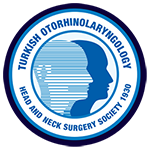ABSTRACT
Objective:
Especially in the summer season, there is an increased incidence of ear infections in the children who attend to the swimming pools. The most frequent ear infection in this group is otitis externa. This study was planned in order to examine whether the microbiologic flora of the normal external auditory canal (EAC) is changed by the pool environment in the presence or absence of cerumen; and to evaluate the relationship of these changes with the external otitis.
Methods:
Ear swab samples of EAC from 197 children were taken before and 1 month after the swimming course. These samples were evaluated at the microbiology laboratory after the otoscopic examination of each student.
Results:
The most frequently isolated microorganisms from the samples which were taken before the course were; Staphylococcus epidermidis (76.7%), Diphteroid spp. (47.3%) and alpha-hemolytic streptococci (29.9%) respectively. After the course period, it was determined that the percentage of isolated microorganisms changed, although the order of the frequency of the first three microorganism remained the same (Staphylococcus epidermidis 75.9%, Diphteroid spp. 56.3% and alpha-hemolytic streptococci 41.1%). Only one case of external otitis due to Pseudomonas aeruginosa was seen in the course period.
Conclusions:
It was concluded that an alteration in the microbiologic flora of the EAC and the presence or absence of cerumen do not play a role in the development of EAC infections provided that the hygienic conditions are constituted and EAC skin is not traumatized.
ÖZET
Amaç:
Özellikle yaz aylarında yüzme havuzuna giren çocuklarda eksternal otit sıklığında bir artış görülmektedir. Bu çalışma serümen varlığı ya da yokluğunda normal dış kulak yolu florasının havuz ortamı tarafından değiştirilip değiştirilmediğini ve varsa bu değişikliklerin dış kulak yolu enfeksiyonları ile ilişkisini araştırmak amacı ile planlandı.
Yöntem:
197 yüzme kursu öğrencisinin dış kulak yolundan kurs öncesi ve bir aylık kurs süreci sonunda sürüntü örnekleri alındı ve mikrobiyolojik olarak incelendi.
Bulgular:
Kurs öncesi en sık izole edilen bakteriler sırası ile; Staphylococcus epidermidis (%76.6), Diphteroid türleri (%47.3) ve alfa-hemotilik streptokoklar (%29.9) idi. Kurs sonunda izole edilen mikroorganizmaların oranları değişmekle birlikte görülme sıklığında bir değişim olmadı. (Staphylococcus epidermidis %75.9, Diphteroid türleri %56.3 ve alfa-hemotilik streptokoklar %41.1). Kurs süreci sırasında yalnızca bir hastada Pseudomonas aeruginosa'ya bağlı eksternal otit tablosu görüldü.
Sonuç:
Elde edilen bulgular ışığında uygun hijyenik koşulların sağlanması ve dış kulak yolu cildinin travmatize edilmemesi koşulu ile serümen varlığı ya da yokluğunun ve dış kulak yolu florasında meydana gelen değişikliklerin dış kulak yolu enfeksiyonlarının gelişiminde rol oynamadığı sonucuna varıldı.



